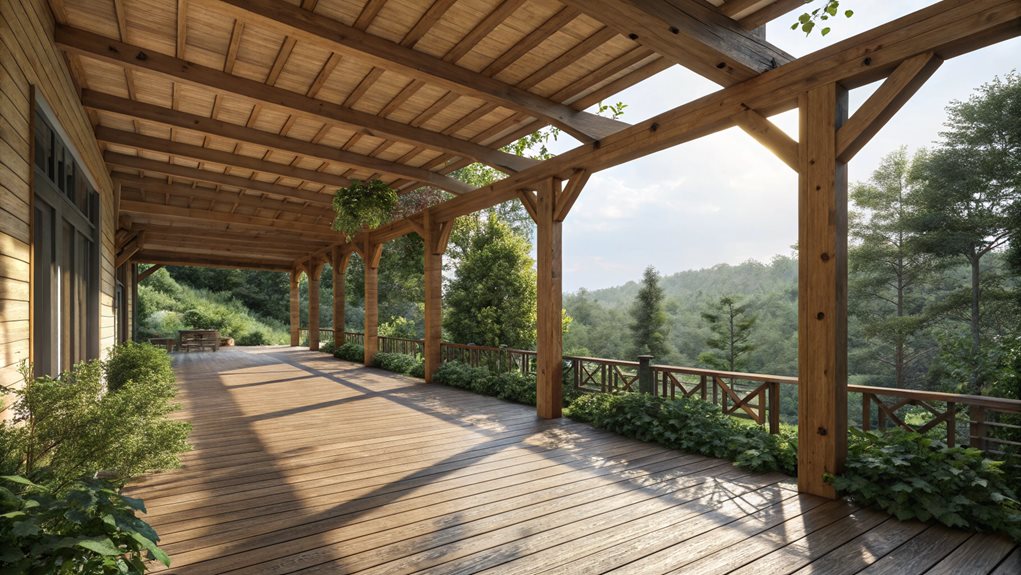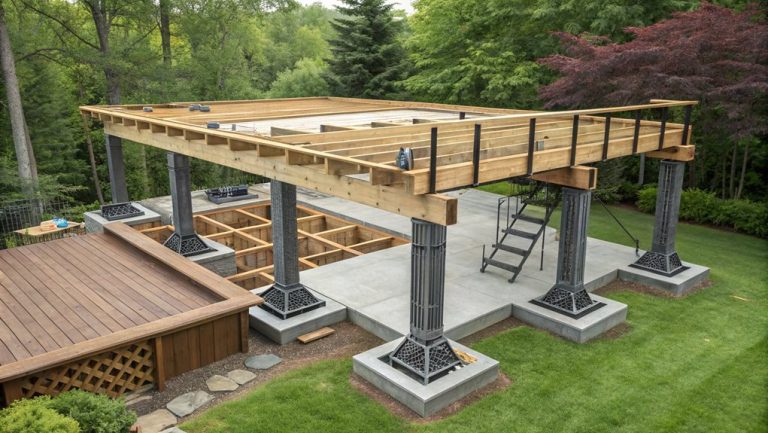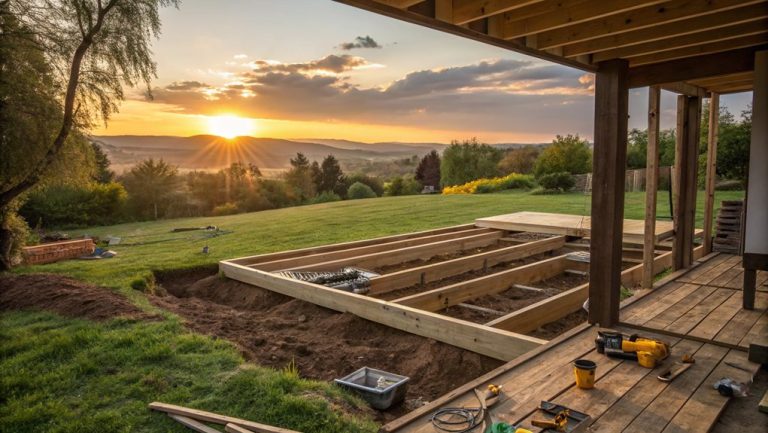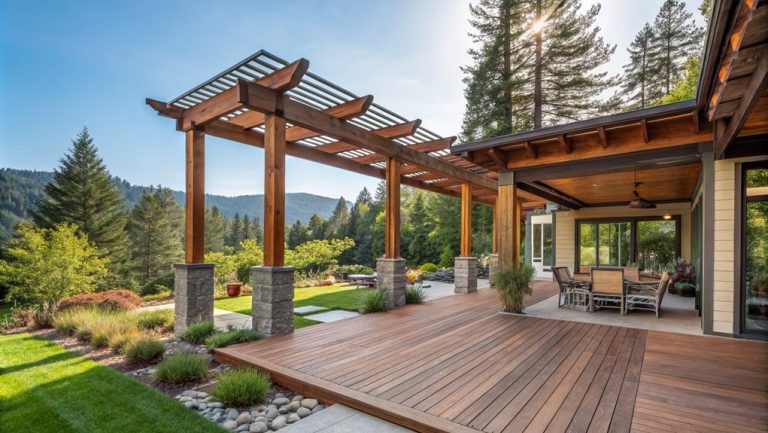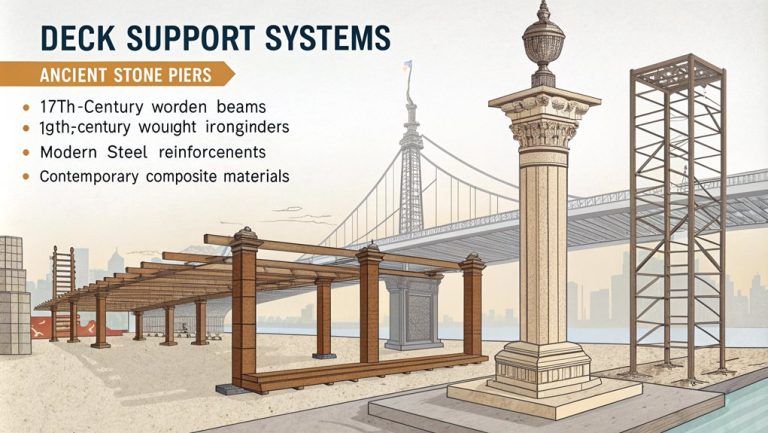Why Structural Support Is Crucial for Deck Safety
Structural support is vital for deck safety as it guarantees stability and compliance with safety regulations. The foundation must be level and anchored securely, with footings extending below the frost line to prevent shifting. Ledger board connections must use corrosion-resistant fasteners, adhering to local building codes, to avert structural failure. Support posts and beams, properly aligned and spaced, form the deck's backbone, demanding choice materials like rot-resistant woods or metals. Railings must meet height standards with secure, durable connections. Fasteners require precise spacing for load distribution, preventing long-term deterioration. Further exploration will reveal additional critical factors for safety.
Expert Highlights
- Structural support ensures overall deck stability and prevents potential collapse, safeguarding users from accidents.
- Properly designed footings maintain deck integrity by supporting weight and distributing it evenly to the ground.
- Secure connections prevent shifting and deterioration, reducing the risk of structural failures over time.
- Adequate spacing and fastening enhance load distribution, meeting safety standards and prolonging the deck's lifespan.
- Solid structural support mitigates environmental impacts, such as erosion and frost, bolstering the deck's resilience.
Foundation and Footings
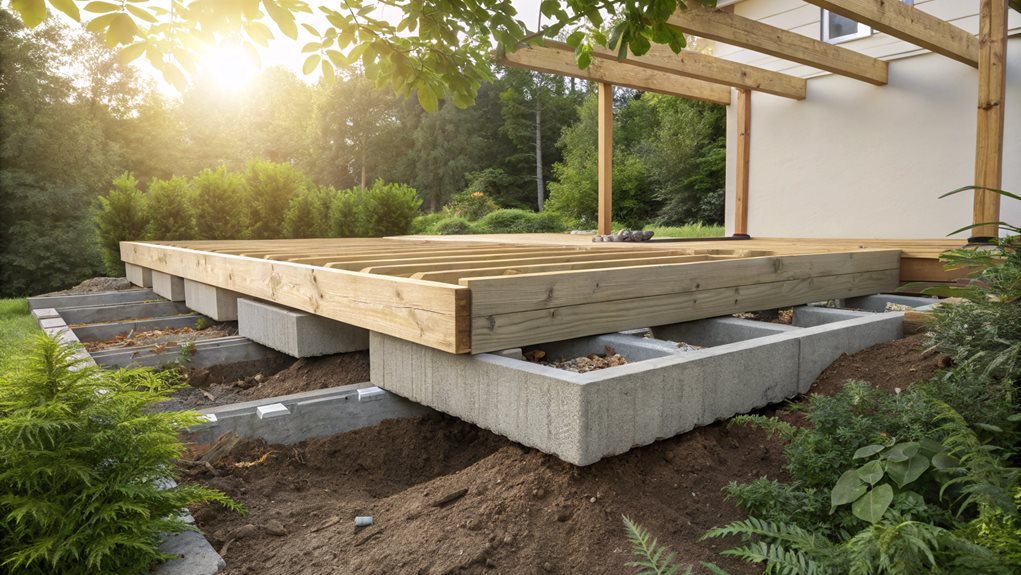
A well-constructed deck begins with a solid foundation and properly designed footings, as these elements are critical for overall stability and safety. Guaranteeing the foundation is level and securely anchored to the ground is imperative; any underlying issues may lead to shifts or settlement, which compromise structural integrity. The local soil type and groundwater conditions greatly influence how foundations should be built, often requiring tailored construction methods. Footings, on the other hand, need to be set adequately deep, extending below the frost line, and properly sized to distribute weight evenly. Constructed from durable materials like concrete, these components must withstand environmental pressures. Regular inspection of the wooden deck components is also necessary to prevent rotting and decay that could affect the structural integrity of the overall deck. Ensuring proper alignment and spacing of support posts is essential for even weight distribution across the deck structure. Compliance with local building codes and regulations ensures that these elements are designed to standards and can adequately support the deck. Regular inspections and adherence to local building codes certify that both the foundation and footings remain robust over time.
Ledger Board Connection
The ledger board connection plays a pivotal role in the structural safety and integrity of a deck. This crucial component is essential for preventing potential dangers like fire risks associated with wood decks and structural failure. Additionally, it is essential that this connection complies with local building codes and regulations, which dictate the types and number of fasteners necessary to guarantee safety and functionality. To ensure footings are solid and stable, regular checks for any signs of shifting or deterioration are vital. An emphasis on high-quality materials and construction techniques further enforces durability and resilience over time. Secure fastening of the ledger board to the residence, using corrosion-resistant fasteners, is indispensable. These must be spaced correctly to evenly distribute the load and be accompanied by metal connectors for a continuous load path. The risk of deck collapse, leading to serious injury or fatality, underscores the importance of regular inspections and maintenance. Signs of wear, damage, or corrosion need immediate attention, with professional inspections recommended every few years to identify hidden issues.
Support Posts and Beams
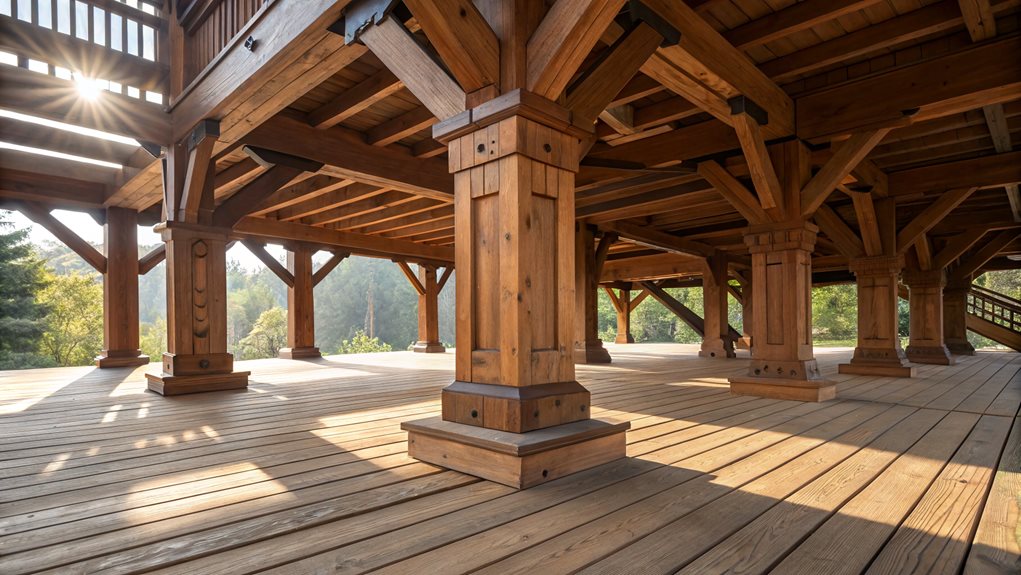
Support posts and beams serve as the backbone of a deck's structure, guaranteeing stability and safety. Proper alignment and spacing are indispensable to distribute weight evenly and prevent structural issues.
Unevenly spaced or misaligned posts can lead to instability, indicating potential construction flaws requiring professional inspection. The choice of materials for posts is equally important; environmental conditions dictate whether to use rot-resistant woods or metals, each requiring regular inspection for degradation.
For structural soundness, connection points must be properly secured with corrosion-resistant fasteners and metal connectors that maintain load distribution to resist forces such as gravity and lateral motion. It's important to remember that building codes and industry best practices guide these decisions to ensure deck safety and durability. Consistent inspections are essential, focusing on alignment, spacing, and connection integrity to preserve the deck's safety and functionality.
Railings and Handrails
Preserving safety and compliance in railings and handrails is a fundamental aspect of deck construction that extends beyond mere aesthetic appeal. Railings and handrails must adhere to specific standards to safeguard safety and functionality. Key considerations include:
- Railing Height and Design: Typically, railings should be around 36 inches high and include vertical balusters to prevent accidents. Baluster spacing must be optimized for both safety and visibility.
- Material and Durability: Use materials resistant to environmental factors, such as rot-resistant wood and corrosion-resistant metal, for long-lasting structural integrity.
- Guardrail Stability: Secure anchoring and sturdy connections are crucial for resisting concentrated loads, preventing failures.
- Handrail Safety: Properly install sturdy handrails on stairs, guaranteeing they support required loads and extend correctly for user safety.
A well-designed porch enhances curb appeal and functions as a focal point of the home, providing both beauty and safety as part of a comprehensive deck installation. Each aspect contributes to communal safety and belonging.
Fasteners and Connections
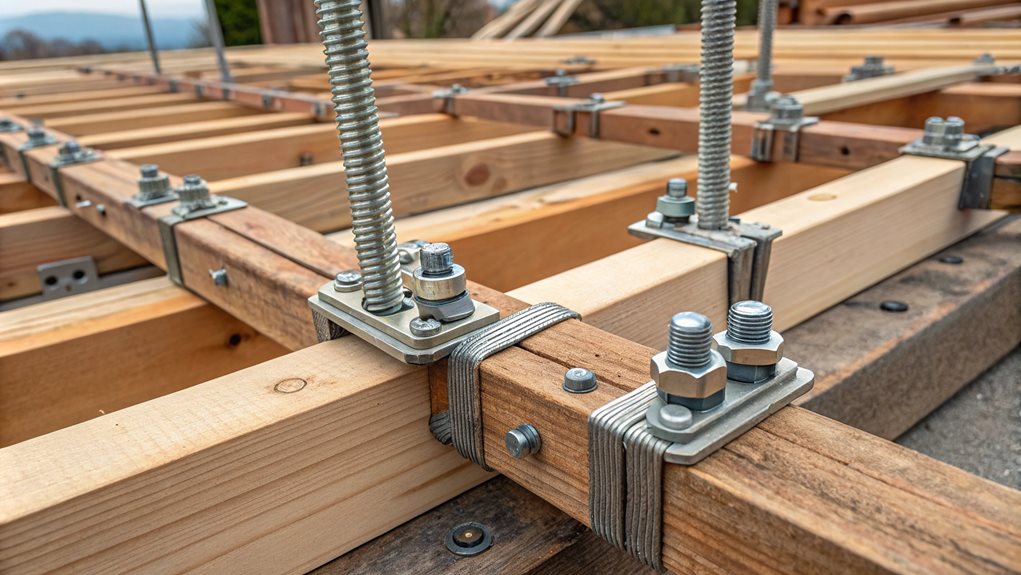
When it comes to ensuring deck safety, the use of corrosion-resistant materials in fasteners is essential, as they prevent deterioration from environmental exposure, especially in moisture-prone areas. Additionally, ideal spacing of fasteners is crucial to maintain even stress distribution across the deck structure, minimizing the risk of structural failure over time. By focusing on these elements, homeowners can substantially improve their deck's durability and safety, aligning with best practices for long-term structural integrity. Utilizing custom cedar deck design principles, homeowners can further enhance the aesthetic appeal and structural soundness of their decks, ensuring they complement the home's architecture and withstand various environmental conditions.
Corrosion-Resistant Material Importance
Deck construction and maintenance hinge on the selection of corrosion-resistant materials, which play a critical role given the exposure to environmental elements such as rain, snow, and humidity. These materials are crucial to maintain structural integrity and safeguard safety.
Corrosion of metal hardware can lead to significant weakening, presenting a danger to those who rely on the deck for their gatherings. Choosing appropriate materials helps extend the deck's lifespan, supporting its role as a central part of community activities.
Consider the following corrosion-resistant options:
- Stainless Steel Fasteners: Highly resistant to harsh weather.
- Galvanized Fasteners: Zinc-coated to deter rust.
- Brass or Bronze Fasteners: Offer reliable corrosion resistance.
- Coated Screws and Nails: Protective coatings prevent corrosion.
Selecting these materials facilitates a secure communal space.
Optimal Fastener Spacing
Proper fastener spacing is a critical factor in maintaining the structural integrity and longevity of a deck. Uniform spacing guarantees even stress distribution, key in preventing structural degradation. Local building codes should guide spacing specifications to avert uneven stress that threatens structural soundness. Misalignment of support and deck components can result from inconsistent spacing, jeopardizing the deck's overall stability. The fasteners themselves, chosen for their specific application, should match the deck's material demands in type and quality, balancing load-bearing needs and durability.
| Component | Ideal Spacing | Importance |
|---|---|---|
| Joists | 16" on center | Supports deck boards evenly |
| Ledger Board | 6" max apart | Prevents deck collapse |
| Rail Posts | 6' max spacing | Confirms safety and support |
| Deck Boards | 1/4" apart | Allows for expansion/contraction |
| Beam Connections | 4'-6' spacing | Provides essential load support |
Consistent, code-compliant fastener spacing is crucial for deck safety.
Maintenance and Inspections
Ensuring the safety and longevity of a deck requires diligent maintenance and regular inspections, particularly through proactive seasonal practices. Homeowners benefit from professional inspections, which can identify issues not readily visible to the untrained eye, thus safeguarding against future safety hazards. Incorporating premium decking materials enhances both the durability and aesthetic appeal of the deck, ensuring it can withstand various weather conditions. Employing effective issue prevention strategies, such as promptly repairing loose connections and ensuring proper water drainage, is essential to preserving the structural integrity of the deck.
Seasonal Maintenance Practices
A well-maintained deck enhances safety and longevity, demanding regular seasonal maintenance practices. By following a routine, homeowners guarantee their decks remain secure and inviting for gatherings.
Regular inspections can prevent minor issues from escalating:
- Inspect Deck Components: Look for loose railings, corroded connectors, and wood decay to safeguard structural integrity.
- Clean the Deck: Debris removal reduces slipperiness while preventing algae and mold growth.
- Check for Environmental Damage: Identify water erosion and the impact of extreme weather to maintain stability.
- Verify Compliance and Safety: Confirm baluster spacing, railing heights, and securely install electrical components to meet safety standards.
Taking these steps fosters a sense of belonging and responsibility, affirming that your outdoor space is safe for everyone.
Professional Inspection Benefits
For thorough deck safety and longevity, professional inspections offer invaluable insights that go beyond basic maintenance practices. Regular inspections can identify potential safety hazards before they evolve into major issues, safeguarding your investment and ensuring peace of mind.
Experts assess critical components such as ledger boards, support posts, and railings to confirm they are secure. Thorough evaluations include the deck's design, alignment, and spacing of support posts, ensuring even weight distribution as per local codes. The suitability of materials used and their resilience to weather conditions are scrutinized.
Additionally, professionals detect hidden dangers, like corrosion and wood rot, unseen in DIY checks. Promptly addressing these concerns extends the deck's lifespan, ultimately fostering an inclusive and secure environment for all.
Issue Prevention Strategies
Regularly maintaining and inspecting a deck is key for preventing issues that could compromise structural integrity and safety. To guarantee your deck remains a safe and welcoming space, consider these crucial steps:
- Inspections: Conduct at least annual inspections to identify and address signs of wear or structural issues. This includes checking footings and ledger boards for stability.
- Maintenance: Clean regularly to prevent debris, algae, or mold growth. Reseal surfaces every few years to protect against moisture and UV damage.
- Hazard Management: Immediately address loose connections and signs of wood rot or pest infestations. Ensuring stability is of paramount importance.
- Seasonal Preparations: Clear obstacles and prepare for weather changes. Use proper lighting and secure areas to maintain safety year-round.
These strategies foster a safer and more enjoyable deck environment.
Deck Building And Design FAQ
How Do Weather Conditions Affect Deck Safety and Longevity?
Weather conditions profoundly impact deck safety and durability by causing material deterioration, structural instability, and surface hazards. Regular inspection, maintenance, and suitable material selection are essential to mitigate these effects and maintain a safe, long-lasting outdoor space.
What Are Common Signs of a Failing Deck Structure?
Common signs of a failing deck structure include missing or corroded connections, loose railings, uneven weight distribution, rot, and insect damage in wood, water damage, uneven or loose stairs, inadequate railing height, and shifting footings.
How Can I Improve My Deck's Resistance to Natural Disasters?
To enhance your deck's resilience against natural disasters, guarantee it complies with local building codes, utilizes corrosion-resistant materials, and employs a continuous load path with metal connectors. Regularly inspect and maintain all structural components and secure footings.
Are There Innovative Materials for Building Safer Decks?
Innovative decking materials, such as composite decking and advanced wood treatments, offer enhanced safety and durability. These materials provide resistance to environmental conditions and improve traction, aligning with community needs for sustainable, long-lasting, and secure outdoor spaces.
What Is the Impact of Deck Design on Structural Safety?
Deck design profoundly influences structural safety by dictating load distribution, joist spacing, and support placement. Thoughtful design fosters compliance with building codes, guarantees durability, and maximizes safety, contributing to a sense of security and communal enjoyment.

